Rural Scotland Key Facts 2021
Biennial compendium publication comparing and contrasting statistics on key policy topics such as People and Communities, Services and Lifestyle, Economy and Enterprise broken down by Remote Rural, Accessible Rural and the Rest of Scotland.
This document is part of a collection
Services and Lifestyle

Access and Convenience of Services
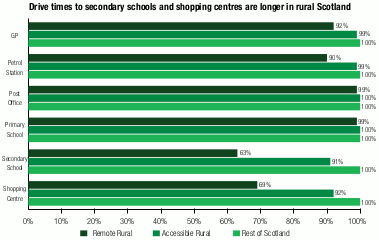
Source: Scottish Index of Multiple Deprivation 2020 (Using Scottish Government Urban Rural Classification 2016)
Figure 4 shows that only rural areas of Scotland are not within a 15 minute drive time to key services. This is the case for all the services for remote rural areas but not for accessible rural areas. However, 99% of people in remote rural areas are within 15 minute drive time to both a post office and a primary school.
The greatest difference observed in drive time is to the nearest secondary school. In remote rural areas, 63% people live within a 15 minute drive time to a secondary school, compared to 91% of people in accessible rural areas and 100% of people in the rest of Scotland.
This is closely followed by the differences in observed drive time to the nearest shopping centre. While 100% of people in the rest of Scotland live within a 15 minute drive time to a shopping centre, only 69% of people in remote rural areas do. This rises to 92% in accessible rural areas.

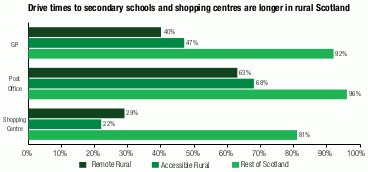
Source: Scottish Index of Multiple Deprivation 2020 (Using Scottish Government Urban Rural Classification 2016)
Figure 5 shows that the proportion of people within a 15 minute drive time to key services by public transport. Unlike Figure 4 no proportions are 100%. The highest proportion is 96% for post offices in the rest of Scotland.
The proportion of people within a 15 minute drive time to key services by public transport are much lower in rural areas compared to the rest of Scotland. The figures are particularly low in rural areas with respect to drive time to the nearest shopping centre, where only 22% of people in accessible rural areas live within a 15 minute drive by public transport. The proportion is slightly higher at 29% in remote rural areas.
Less than half of people living in rural areas of Scotland live within a 15 minute drive time to a GP by public transport, this compares to 92% in the rest of Scotland.
This is reflected in the levels of satisfaction with quality of public transport services shown in Figure 6.

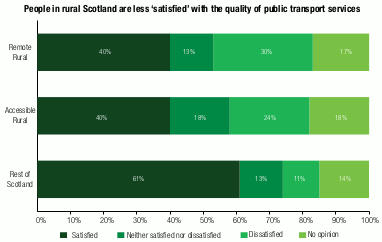
Source: Scottish Household Survey 2019 (Using Scottish Government Urban Rural Classification 2016)
Figure 6 shows that while 61% of people in the rest of Scotland are ‘satisfied’ with the quality of public transport service delivered in their area, only 40% of people in rural areas are ‘satisfied’ the delivered public transport service.
In contrast to this, 30% of people in remote rural areas and 24% in accessible rural areas are ‘dissatisfied’ with the quality of public transport service delivered in their area. The proportion of people ‘dissatisfied’ in the rest of Scotland is only 11%.

| Remote Rural | Accessible Rural | Rest of Scotland | ||
|---|---|---|---|---|
| Households with home internet access | 87% | 90% | 87% | |
| Base | 280 | 320 | 2,400 | |
| How these households1 connect to the internet: | DSL broadband | 66% | 59% | 40% |
| Superfast broadband (e.g. Virgin Media, BT Infinity) | 29% | 36% | 53% | |
| Broadband via satellite, public WiFi | 3% | 4% | 5% | |
| Mobile broadband via mobile phone network (3G or 4G) via a mobile phone, smartphone or tablet | ||||
| 8% | 8% | 11% | ||
| Dial-up access | - | - | - | |
| Other | 1% | 0% | 1% | |
| Base | 240 | 280 | 2,080 | |
Source: Scottish Household Survey 2019 (Using Scottish Government Urban Rural Classification 2016)
Notes:
1. Households can connect to the internet via multiple ways.
The proportion of households with home internet access is very similar across all areas of Scotland, with at least 87% of households in the different areas having home internet access.
Of those households with home internet access, almost all of them have a broadband connection through either Digital Subscriber Line (DSL) broadband or superfast broadband. In remote rural areas, two thirds of households connect using DSL broadband and 29% use superfast broadband. This compares to 53% in the rest of Scotland who connect using superfast broadband and 40% using DSL broadband.
Within the Economy National Outcome of the National Performance Framework there is a National Indicator called Access to Superfast Broadband, which measures the proportion of residential and non-residential premises where superfast broadband is available.

Cultural Engagement
| Remote Rural | Accessible Rural | Rest of Scotland | |
|---|---|---|---|
| Yes | 73% | 82% | 81% |
| Excluding the cinema | 66% | 75% | 75% |
| No | 27% | 18% | 19% |
| Total | 100% | 100% | 100% |
| Base | 1,020 | 1,050 | 7,710 |
Source: Scottish Household Survey 2019 (Using Scottish Government Urban Rural Classification 2016)
Notes:
1. A cultural event includes: cinema, library, classical music, live music event, theatre, dance show event, historic place, museum, art gallery, exhibition, street arts, culturally specific festival, book festival, archive office and streaming live performance.
The proportion of people who have attended any cultural event in the previous 12 month is highest in accessible rural areas at 82%, closely followed by the rest of Scotland at 81%. The proportion decreases to 73% in remote rural areas.
Going to the cinema is the most popular cultural event across all areas, with around half of people saying that have been to the cinema in the past 12 months. When those people who have only gone to the cinema are excluded, the proportion of people who have attended a cultural event in the previous 12 months decreases across all areas of Scotland in a similar way. There is a decrease of around seven percentage points in the proportion of people who have attended any cultural event.
Within the Culture National Outcome of the National Performance Framework there is a National Indicator called Attendance at Cultural Events or Places of Culture, which measures the proportion of adults who have attended or visited a cultural event or place in the last 12 months.

| Remote Rural | Accessible Rural | Rest of Scotland | |
|---|---|---|---|
| Yes | 80% | 77% | 74% |
| Excluding reading | 47% | 47% | 48% |
| No | 20% | 23% | 26% |
| Total | 100% | 100% | 100% |
| Base | 1,020 | 1,050 | 7,710 |
Source: Scottish Household Survey 2019 (Using Scottish Government Urban Rural Classification 2016)
Notes:
1. A cultural event includes: reading, dance, play instrument, taken part in play, singing group/choir, art sculpture, photography, film making, computer artwork animation, crafts, creative writing, viewed performances online, viewed cultural content online, shared art creative content online and other cultural.
In contrast to what was seen in Table 15, participation in any cultural event in the previous 12 months is highest in remote rural areas (80%). This compares to 77% in accessible rural areas and 74% in the rest of Scotland.
Reading is the most popular cultural event to participate in across Scotland. Over 60% of people have read within the previous 12 months. When those people that have only read are excluded the level of participation in cultural events for all areas drops by around 30 percentage points. The highest proportion of participation is then in the rest of Scotland at 48%. For both remote rural and accessible rural areas it is 47%.
Within the Culture National Outcome of the National Performance Framework there is a National Indicator called Participation in a Cultural Activity, which measures the proportion of adults who have participated in a cultural activity in the last 12 months.

Travel Patterns
| Remote Rural | Accessible Rural | Rest of Scotland | |
|---|---|---|---|
| Walking | 14% | 6% | 13% |
| Driver of a car or van | 75% | 82% | 60% |
| Passenger in a car or van | 3% | 4% | 5% |
| Bicycle | 1% | 1% | 3% |
| Bus (ordinary or works) | 3% | 2% | 11% |
| Rail | 1% | 4% | 6% |
| Other | 2% | 2% | 2% |
| Total | 100% | 100% | 100% |
| Base | 350 | 410 | 3,290 |
Source: Scottish Household Survey 2019 (Using Scottish Government Urban Rural Classification 2016)
Table 17 shows that people in rural areas are more likely to drive to work/education, more so in accessible rural areas, and less likely to take public transport, compared to the rest of Scotland.
The highest proportion of adults who walk to work/education is 14% in remote rural areas. This is followed by the rest of Scotland where it is 13%. In accessible rural areas only 6% of adults walk to work/education.
Within the Health National Outcome of the National Performance Framework there is a National Indicator called Journeys by Active Travel, which measures the proportion of short journeys made by adults (16+) that are made by walking or cycling.

| Remote Rural | Accessible Rural | Rest of Scotland | |
|---|---|---|---|
| Walking/bicycle | 28% | 31% | 59% |
| Passenger in a car/van | 27% | 27% | 25% |
| Bus (ordinary, school, works, or private) | 42% | 37% | 14% |
| Other | 3% | 5% | 2% |
| Total | 100% | 100% | 100% |
| Base | 180 | 220 | 1,510 |
Source: Scottish Household Survey 2019 (Using Scottish Government Urban Rural Classification 2016)
Table 18 shows that children in rural areas are more likely to travel to school by bus than by any other mode of transport. The proportion is highest in remote rural areas at 42% compared to 37% in the accessible rural areas.
Whereas, children in the rest of Scotland are more likely to walk or cycle to school compared to children in rural areas.
Figure 4 shows that a greater proportion of children living in rural areas are outwith 15 minutes drive to primary schools and in particular, secondary schools. This is likely to have an impact on the lower proportion of children in rural areas that normally either walk or cycle to school.

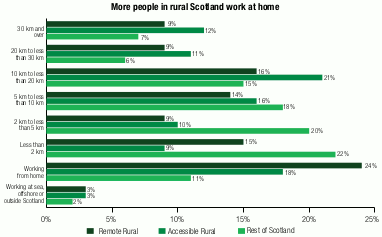
Source: Scottish Household Survey 2017, 2018 and 2019 (Using Scottish Government Urban Rural Classification 2016)
Notes:
1. The distance to work is a calculation of the straight line between the postcode of place of residence and postcode of workplace.
The highest proportion of people living in remote rural areas work from home (24%). The proportion of people working at home is lower in accessible rural areas (18%) and lowest for people in the rest of Scotland (11%).
In accessible rural areas, the highest proportion of people travel between 10 km and 20 km to work (21%). This compares to 16% in remote rural areas and 15% in the rest of Scotland, while for the rest of Scotland the highest proportion of people travel less than 2 km to work (22%). For remote rural areas 15% of people travel less than 2 km to work, In accessible rural areas the proportion is only 9%.
Of people living in accessible rural areas, 32% travel between 10 km and 30 km to work. As accessible rural areas are within a drive time of 30 minutes to the nearest settlement with a population of 10,000 or more, this could indicate that people living in accessible rural areas are commuting to urban areas to work.

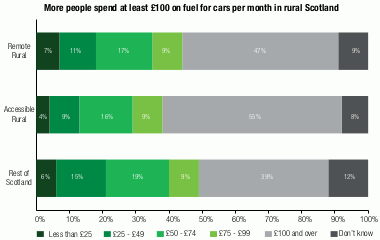
Source: Scottish Household Survey 2019 (Using Scottish Government Urban Rural Classification 2016)
Figure 8 shows that residents in rural Scotland are more likely than those in the rest of Scotland to spend over £100 per month on fuel for their cars. The proportion of those spending more than £100 per month on fuel for their cars is highest in accessible rural areas at 55%. The proportion is 47% in remote rural areas. In the rest of Scotland this falls to 39%. A higher level of expenditure on fuel for cars is likely to be, in part, due to longer driving distances to key services, as shown in Figure 4, as well as the distance travelled to work for people in accessible rural areas, as shown in Figure 7.

Education
| Remote Rural | Accessible Rural | Rest of Scotland | |
|---|---|---|---|
| Positive Destinations | 95% | 95% | 92% |
| Higher Education | 35% | 39% | 38% |
| Further Education | 18% | 23% | 24% |
| Training1 | 3% | 2% | 2% |
| Employment | 37% | 30% | 27% |
| Voluntary Work | 0% | 1% | 0% |
| Personal Skills Development2 | 0% | 0% | 0% |
| Other Destinations | 5% | 5% | 8% |
| Unemployed Seeking | 2% | 2% | 4% |
| Unemployed Not Seeking | 2% | 2% | 2% |
| Unknown | 1% | 1% | 1% |
| Number of Leavers | 3,043 | 5,835 | 40,777 |
Source: Destination of Leavers from Scottish Schools 2018-19 (Based on school leaver’s home address and Scottish Government Urban Rural Classification 2016)
Notes:
1. For 2018-19, support previously recorded as Activity Agreements is recorded in the Training category. A description of Activity Agreements can be found under Definitions in the Notes section at the end of this publication. 2. All school leavers undertaking Personal Skills Development (PSD) are now recorded in a new standalone PSD category.
Table 19 shows that 95% of school leavers in rural areas go onto a positive destination. This compares to 92% in the rest of Scotland. Within the positive destinations, the proportion of school leavers who proceed to higher education is very similar across all three areas of Scotland. The proportion is highest in accessible rural areas at 39% and lowest in remote rural areas at 35%.
Fewer school leavers in remote rural areas go on to further education compared to school leavers in accessible rural areas and the rest of Scotland.
The highest proportion of school leavers in remote rural areas go straight into employment (37%).
For accessible rural areas the proportion is 30% and for the rest of Scotland it is 27%.
The proportion of school leavers that are unemployed and seeking work is highest in the rest of Scotland (4%). This is marginally higher than the 2% in rural areas. The proportion of the remaining other destinations are the same across all areas of Scotland.

| Remote Rural | Accessible Rural | Rest of Scotland | |
|---|---|---|---|
| Degree Level or Equivalent | 26% | 33% | 31% |
| HNC/HND or equivalent | 17% | 18% | 15% |
| Higher/A-Level or equivalent | 26% | 22% | 22% |
| Credit Standard Grade or equivalent | 17% | 16% | 15% |
| General Standard Grade or equivalent | 3% | 1% | 2% |
| Other | 5% | 3% | 5% |
| No Qualifications | 7% | 7% | 11% |
| Total | 100% | 100% | 100% |
Source: Annual Population Survey in Scotland, January to December 2019, ONS (Using Scottish Government Urban Rural Classification 2016)
Notes:
1. Those with unknown qualification status have been excluded from the calculations.
2. Estimates shaded grey are based on a small sample size. This may result in a less precise estimates, which should be used with caution.
3. Unshaded estimates are based on a larger sample size. This is likely to result in estimates of higher precision, although they will still be subject to some sampling variability.
Table 20 shows that levels of school and college education attained are broadly comparable for all areas of Scotland. The proportion of people in accessible rural areas (33%) and the rest of Scotland (31%) that have a degree level qualification or equivalent are higher compared to remote rural areas (26%).
In remote rural areas the proportion of people who have Higher/A-Level or equivalent as their highest qualification is 26%. This compares to both 22% in the accessible rural areas and the rest of Scotland.
It should be noted that the information in this table may reflect where people choose to live after achieving their qualifications, rather than reflecting attainment by those initially living in rural areas.

Health
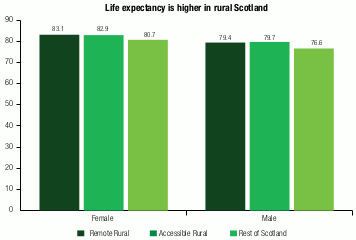
Source: Life Expectancy Statistics, National Records of Scotland (Using Scottish Government Urban Rural Classification 2016)
Figure 9 shows that the life expectancy in rural areas is higher compared to the rest of Scotland. As well as that females have a higher life expectancy than males for all areas of Scotland. The life expectancy of people born in Scotland is highest for females in remote rural areas but in accessible rural areas for males.
The life expectancy for females in rural areas is around 83 years. This is just over two years higher than for females in the rest of Scotland. The difference in life expectancy for males is slightly larger at around three years, with life expectancy being around 79.5 years in rural Scotland.
It should be noted that there is an overall increasing trend in life expectancy at birth for both males and females in Scotland.
| Remote Rural | Accessible Rural | Rest of Scotland | |
|---|---|---|---|
| Emergency admissions rate per 100,000 population | 9,414 | 9,630 | 11,367 |
| Cancer admissions rate per 100,000 population | 3,849 | 3,417 | 3,696 |
Source: Public Health Scotland (Using Scottish Government Urban Rural Classification 2016)
Table 21 shows that the highest rates per 100,000 population for emergency admissions was in the rest of Scotland in 2019, while the lowest rate of emergency admission was in remote rural areas. In contrast to this the highest rates per 100,000 population for cancer admissions was in remote rural areas, with the lowest cancer admission rate being in accessible rural areas.
Across all areas of Scotland the emergency admission rate is higher than the cancer admission rate. The admission rates are around three times higher for accessible rural areas and the rest of Scotland, but only two and a half times higher for remote rural areas.
Please note that these data are not adjusted to account for the different age profiles of areas (see Figure 1) which would affect admission rates.

Housing
| Remote Rural | Accessible Rural | Rest of Scotland | |
|---|---|---|---|
| Detached house | 57% | 50% | 18% |
| Semi-detached house | 22% | 25% | 22% |
| Terraced house | 14% | 18% | 20% |
| Flat/Maisonette | 7% | 7% | 39% |
| Other1 | 0% | 0% | 0% |
| Total | 100% | 100% | 100% |
| Base | 1,070 | 1,150 | 8,320 |
Source: Scottish Household Survey 2019 (Using Scottish Government Urban Rural Classification 2016)
Notes:
1. Other includes caravans, mobile homes and houseboats as well as other kinds of accommodation.
Table 22 shows that while over half of properties in rural Scotland are detached houses (57% in remote rural areas and 50% in accessible rural areas), only 18% of properties in the rest of Scotland are detached houses.
In rural areas over 90% of properties are houses or bungalows. This compares to 60% in the rest of Scotland. In contrast, in the rest of Scotland, flats account for 39% of the housing stock, with only 7% of properties in both remote rural and accessible rural areas being flats.
| Remote Rural | Accessible Rural | Rest of Scotland | |
|---|---|---|---|
| Number of Residential Property Sales | 4,916 | 9,228 | 61,256 |
| Change from 2019 | -14% | -8% | -18% |
| Mean Residential Property Price | £198,908 | £228,566 | £171,362 |
| Change from 2019 | 6% | 9% | 4% |
| Median Residential Property Price | £172,000 | £200,000 | £142,500 |
| Change from 2019 | 6% | 11% | 4% |
Source: House Price Statistics, Registers of Scotland (Using Scottish Government Urban Rural Classification 2016)
Notes:
1. These figures include all market value residential sales in Scotland between £20,000 and £1,000,000 and are based on the date of registration with Registers of Scotland (RoS). The figures includes both cash sales and properties bought with a mortgage.
2. The 3-fold Scottish Government Urban Rural Classification 2016 was attached to all residential property sales in 2019 and 2020. The Urban Rural Classification given to each title was calculated by overlaying the title seed point (a point marker used to identify the position of a Land Register title on the Ordnance Survey base map) with the Urban Rural Classification 2016. There are a number of titles (12% in both 2019 and 2020) which could not be given an Urban Rural category as the title has no seed point. These property sales have been excluded from the figures above.
3. Since March 2020, fewer transactions have been received by RoS than expected because of the introduction of government measures to reduce the spread of the COVID-19. These measures included the UK lockdown announcement on Monday 23 March, the temporary closure of the application record by RoS from Wednesday 25 March and the advice from the Scottish Government to delay moving home wherever possible. From 29 June, all home moves were permitted, provided they could be carried out safely. Caution should be used when comparing the 2019 and 2020 figures.
As would be expected due to the COVID-19 restrictions, the number of residential properties sales was lower in 2020 compared to 2019 for all areas of Scotland. The greatest decrease was in the rest of Scotland (-18%) and the smallest decrease was in accessible rural areas (-8%).
While the number of sales was lower in 2020 compared to 2019, both the mean and median residential property prices increased for all areas of Scotland. The highest mean and median increase in property prices were for accessible rural areas. The highest mean and median property prices in 2020, based on actual house sales, were also for accessible rural areas. The lowest mean and median property prices were for the rest of Scotland.
Please note that property prices do not necessarily compare like with like as prices are not adjusted for property type and size (Table 22 shows the differences in property type across Scotland).

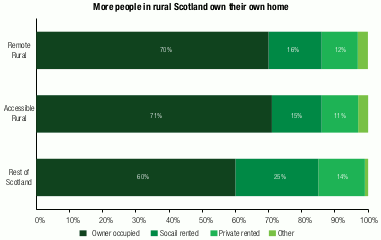
Source: Scottish Household Survey 2019 (Using Scottish Government Urban Rural Classification 2016)
Notes:
1. A description of housing tenure can be found under Definitions in the Notes section at the end of this publication.
Figure 10 shows that rural Scotland has a higher proportion of households that are owner occupied (70% and 71% respectively in remote rural and accessible rural areas), compared with the rest of Scotland (60%). In contrast to this, a smaller proportion of rural households rent from local authorities or housing associations (16% in remote rural areas and 15% in accessible rural areas) than in the rest of Scotland (25%).
The proportion of private renting is more similar across the different areas of Scotland. It is highest in the rest of Scotland at 14% and is 12% in remote rural areas and 11% in accessible rural areas.

| Remote Rural | Accessible Rural | Rest of Scotland | |
|---|---|---|---|
| BC (69-91) | 16% | 29% | 49% |
| D (55-68) | 30% | 41% | 42% |
| E (39-54) | 30% | 18% | 8% |
| FG (1-38) | 24% | 13% | 2% |
| Mean SAP 2012 v9.93 Rating | 51 | 59 | 67 |
| Median SAP 2012 v9.93 Rating | 53 | 61 | 68 |
| Base | 370 | 340 | 2,290 |
Source: Scottish House Condition Survey 2019 (Using Scottish Government Urban Rural Classification 2016)
Notes:
1. For Energy Efficiency Ratings (EERs), band A represents high energy efficiency, while band G denotes low energy efficiency. A full description of Energy Performance Certificates (EPC) and EERs can be found under Definitions in the Notes section at the end of this publication.
2. No A-rated (92-100) dwellings were sampled.
The housing stock in rural Scotland is generally less energy efficient than in the rest of Scotland, particularly for remote rural areas. In remote rural areas, the median energy efficient rating is 53 compared to 61 in accessible rural areas and 68 in the rest of Scotland. Despite the difference in the actual median ratings, the housing stock in accessible rural areas and the rest of Scotland would still be given a band D for their Energy Performance Certificate (EPC). The median rating for the housing stock for the rest of Scotland is however the highest it can be while still remaining in band D. The housing stock in remote rural areas would be in the lower band E.
A higher proportion of the housing stock in rural areas are in the lower bands (F and G) than in the rest of Scotland. In remote rural areas it is 24% and in accessible rural areas it is 13%. This compares to only 2% of the housing stock in the rest of Scotland.

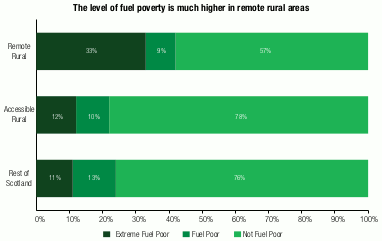
Source: Scottish House Condition Survey 2019 (Using Scottish Government Urban Rural Classification 2013-2014)
Notes:
1. The definition of fuel poverty can be found under Definitions in the Notes section at the end of this publication.
Figure 11 shows that a third of households in remote rural areas are classed as ‘extreme fuel poor’. This compares to only 12% in accessible rural areas and 11% in the rest of Scotland. More households in remote rural areas are classed as ‘extreme fuel poor’ than households that are classed as either ‘extreme fuel poor’ or ‘fuel poor’ in both accessible rural areas and the rest of Scotland.
In accessible rural areas, 78% of households are classed as ‘not fuel poor’ and in the rest of Scotland 76% of households are ‘not fuel poor’. This compares to 57% of properties in remote rural areas.

| Remote Rural | Accessible Rural | Rest of Scotland | |
|---|---|---|---|
| No loft insulation | .. | 1% | 1% |
| Less than 100 mm | .. | 4% | 6% |
| 100 mm to 199 mm | 27% | 25% | 30% |
| 200 mm to 299 mm | 29% | 34% | 35% |
| 300 mm or more | 40% | 36% | 29% |
| Total | 100% | 100% | 100% |
| Base | 340 | 320 | 1,740 |
Source: Scottish House Condition Survey 2019 (Using Scottish Government Urban Rural Classification 2016)
Notes:
1. Dwellings without loft spaces, for example mid-floor flats, are excluded.
2. .. denotes the data has been suppressed due to the base sample size being below 30.
Table 25 shows the presence and thickness of loft insulation in homes. Only 1% of homes, that have lofts, in accessible rural areas and the rest of Scotland have no loft insulation. The proportion for remote rural areas is not available due to the small sample size of homes that have no loft insulation. The same is true for the homes with less than 100 mm of lost insulation in remote rural areas.
The vast majority of homes in Scotland have some loft insulation, the trend is to have a greater thickness of loft insulation. This is particularly true for rural Scotland. In remote rural areas 40% of homes have 300 mm or more of insulation and in accessible rural areas it is 36% of home. This compares to 29% in the rest of Scotland.
Contact
Email: RuralStatistics@gov.scot
There is a problem
Thanks for your feedback